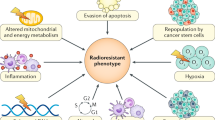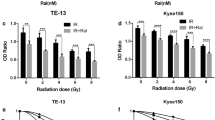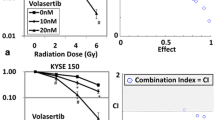Abstract
Aim
This study was performed to investigate the range of optimal concentration and mechanisms of paclitaxel (PXL) radio-enhancement in gastrointestinal cancer cell lines HT29 and MKN45.
Methods
Cell growth inhibition by PXL pretreatment at various concentrations (0–10 μM) followed by irradiation was investigated using a modified MTT assay. To investigate the mechanisms of the observed radio-enhancement, flow cytometry was conducted to define the cell cycle distributions. Furthermore, the alterations in expression of a DNA repair molecule [excision repair cross-complementation group1 (ERCC1)] and an angiogenesis factor [vascular endothelial growth factor (VEGF)] induced by PXL were investigated.
Results
Cytotoxic concentrations of PXL (0.1–10 μM) that cause accumulation of cells in the G2/M phase have strong radio-enhancing effects and inhibit total cell growth. The maximal non-cytotoxic concentration of PXL (0.01 μM) also had a radio-enhancing effect. The expression of the genes of ERCC1 and VEGF induced by radiation was suppressed by PXL pretreatment. The protein secretion of VEGF induced by radiation was suppressed at cytotoxic doses of PXL, and the induced protein secretion of ERCC1 was also suppressed even at maximal non-cytotoxic doses of PXL.
Conclusion
The range of optimal concentration for PXL pretreatment was 0.01–0.1 μM in these cells. Two major mechanisms of radio-enhancement are suggested: (1) PXL induces G2/M arrest leading to increased DNA damage after radiation, which results in mitotic death, and (2) PXL suppresses the expression of radiation-induced DNA repair molecules and angiogenesis factors, resulting in inhibition of cell growth and cell death.






Similar content being viewed by others
References
Rowinsky EK, Donehower RC (1995) Paclitaxel (taxol). N Engl J Med 332:1004–1014
Horwitz SB (1992) Mechanism of action of taxol. Trends Pharmacol Sci 13:134–136
Schiff PB, Horwitz SB (1980) Taxol stabilizes microtubules in mouse fibroblast cells. Proc Natl Acad Sci USA 77:1561–1565
Tishler RB, Schiff PB, Geard CR et al. (1992) Taxol: a novel radiation sensitizer. Int J Radiat Oncol Biol Phys 22:613–617
Liebmann J, Cook JA, Fisher J et al. (1994) Changes in radiation survival curve parameters in human tumor and rodent cells exposed to paclitaxel (taxol). Int J Radiat Oncol Biol phys 29:559–564
Gupta N, Hu LJ, Deen DF (1997) Cytotoxicity and cell-cycle effects of paclitaxel when used as a single agent in combination with ionizing radiation. Int J Radiat Oncol Biol Phys 37:885–895
Steren A, Sevin BU, Perras J et al. (1993) Taxol as a radiation sensitizer: a flow cytometric study. Gynecol Oncol 50:89–93
Rodriguez M, Sevin BU, Perras J et al. (1995) Paclitaxel: a radiation sensitizer of human cervical cancer cells. Gynecol Oncol 57:165–169
Milas L, Hunter NR, Mason KA et al. (1995) Tumor reoxygenation as a mechanism of taxol-induced enhancement of tumor radioresponse. Acta Oncol 34:409–412
Milas L, Hunter NR, Mason KA et al. (1995) Role of reoxygenation in induction of enhancement of tumor radioresponse by paclitaxel. Cancer Res 55:3564–3568
Schmidt-Ullrich RK, Dent P, Grant S et al. (2000) Signal transduction and cellular radiation responses. Radiat Res 153:245–257
Tounekti O, Kenani A, Foray N et al. (2001) The ratio of single- to double-strand DNA breaks and their absolute values determine cell death pathway. Br J Cancer 84:1272–1279
Vousden KH, Lu X (2002) Live or let die: the cell’s response to p53. Nat Rev cancer 2:594–604
Ferrara N (2001) Role of vascular endothelial growth factor in regulation of physiological angiogenesis. Am J Physiol Cell Physiol 280:C1358–C1366
Asano M, Yukita A, Matsumoto T et al. (1995) Inhibition of tumor growth and metastasis by an immunoneutralizing monoclonal antibody to human vascular endothelial growth factor/ vascular permeability factor 121. Cancer Res 55:5296–5301
Gorski DH, Beckett MA, Jaskowiak NT et al. (1999) Blockage of the vascular endothelial growth factor stress response increases the antitumor effects of ionizing radiation. Cancer Res 59:3374–3378
Katoh O, Tauchi H, Kawaishi K et al. (1995) Expression of the vascular endothelial growth factor (VEGF) receptor gene, KDR, in hematopoietic cells and inhibitory effect of VEGF on apoptotic cell death caused by ionizing radiation. Cancer Res 55:5687–5692
Pidgeon G, Barr M, Harmey JH et al. (2001) Vascular endothelial growth factor (VEGF) upregulates Bcl-2 and inhibits apoptosis in human and murine mammary adenocarcinoma cells. Br J Cancer 85:273–278
Hovinga KE, Stalpers LJ, van Bree C et al. (2005) Radiation-enhanced vascular endothelial growth factor (VEGF) secretion in glioblastoma multiforme cell lines-a clue to radioresistance? J Neurooncol 74: 99–103
Dabholkar M, Vionnet J, Bostick-Bruton F et al. (1994) Messenger RNA levels of XPAC and ERCC1 in ovarian cancer tissue correlate with response to platinum-based chemotherapy. J Clin Investig 94:703–708
Murray D, Rosenberg E (1996) The importance of the ERCC1/ERCC4 [XPF] complex for hypoxic-cell radioresistance does not appear to derive from its participation in the nucleotide excision repair pathway. Mutat Res 364:217–226
Wood RD, Mitchell M, Sgouros J et al. (2001) Human DNA repair genes. Science 291:1284–1289
You JS, Wang M, Lee SH (2003) Biochemical analysis of damage recognition process in nucleotide excision repair. J Biol Chem 278:7476–7485
Houtsmuller AB, Rademakers S, Nigg AL et al. (1999) Action of DNA repair endonuclease ERCC1/XPF in living cells. Science 284:958–961
Metzger R, Leichman CG, Danenberg KD et al. (1998) ERCC1 mRNA levels complement thymidylate synthase mRNA levels in predicting response and survival for gastric cancer patients receiving combination cisplatin and fluorouracil chemotherapy. J Clin Oncol 16:309–316
Shirota Y, Stoehlmacher J, Brabender J et al. (2001) ERCC1 and thymidylate synthase mRNA levels predict survival for colorectal cancer patients receiving combination oxaliplatin and fluorouracil chemotherapy. J Clin Oncol 19:4298–4304
Lord RV, Brabender J, Gandara D et al. (2002) Low ERCC1 expression correlates with prolonged survival after cisplatin plus gemcitabine chemotherapy in non-small cell lung cancer. Clin Cancer Res 8:2286–2291
Warnecke-Eberz U, Metzger R, Miyazono F et al. (2004) High specificity of quantitative excision repair cross-complementing 1 messenger RNA expression for prediction of minor histopathological response to neoadjuvant radiochemotherapy in esophageal cancer. Clin Cancer Res 10:3794–3799
Reed E (1998) Platinum–DNA adduct, nucleotide excision repair and platinum based anti-cancer chemotherapy. Cancer Treat Rev 24: 331–344
Melton DW, Ketchen AM, Nunez F et al. (1998) Cells from ERCC1-deficient mice show increased genome instability and a reduced frequency of S-phase-dependent illegitimate chromosome exchange but a normal frequency of homologous recombination. J Cell Sci 111: 395–404
Murray D, Vallee-Lucic L, Rosenberg E et al. (2002) Sensitivity of nucleotide excision repair-deficient human cells to ionizing radiation and cyclophosphamide. Anticancer Res 22:21–26
Britten RA, Liu D, Tessier A et al. (2000) ERCC1 expression as a molecular marker of cisplatin resistance in human cervical tumor cells. Int J Cancer 89:453–457
Yacoub A, McKinstry R, Hinman D et al. (2003) Epidermal growth factor and ionizing radiation up-regulate the DNA repair genes XRCC1 and ERCC1 in DU145 and LNCaP prostate carcinoma through MAPK signaling. Radiat Res 159:439–452
Toiyama Y, Tanaka K, Konishi N et al. (2006) Administration sequence-dependent antitumor effects of paclitaxel and 5-fluorouracil in the human gastric cancer cell line MKN45. Cancer Chemother Pharmacol 57:368–375
Author information
Authors and Affiliations
Corresponding author
Rights and permissions
About this article
Cite this article
Toiyama, Y., Inoue, Y., Hiro, J. et al. The range of optimal concentration and mechanisms of paclitaxel in radio-enhancement in gastrointestinal cancer cell lines. Cancer Chemother Pharmacol 59, 733–742 (2007). https://doi.org/10.1007/s00280-006-0327-1
Received:
Accepted:
Published:
Issue Date:
DOI: https://doi.org/10.1007/s00280-006-0327-1




